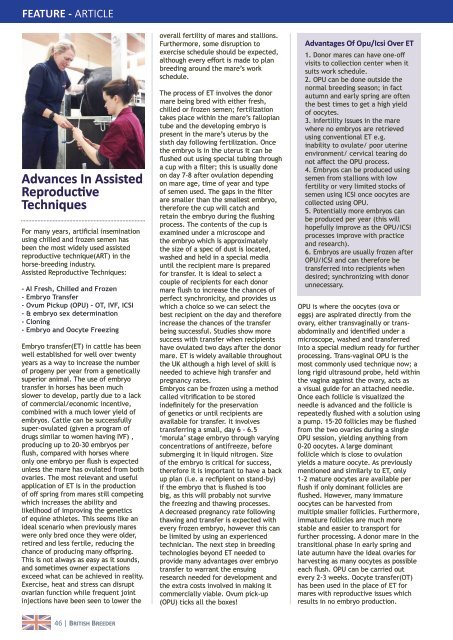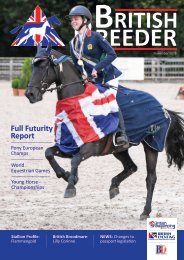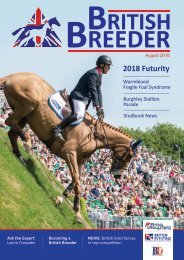Create successful ePaper yourself
Turn your PDF publications into a flip-book with our unique Google optimized e-Paper software.
FEATURE - ARTICLE<br />
Advances In Assisted<br />
Reproductive<br />
Techniques<br />
For many years, artificial insemination<br />
using chilled and frozen semen has<br />
been the most widely used assisted<br />
reproductive technique(ART) in the<br />
horse-breeding industry.<br />
Assisted Reproductive Techniques:<br />
- AI Fresh, Chilled and Frozen<br />
- Embryo Transfer<br />
- Ovum Pickup (OPU) - OT, IVF, ICSI<br />
- & embryo sex determination<br />
- Cloning<br />
- Embryo and Oocyte Freezing<br />
Embryo transfer(ET) in cattle has been<br />
well established for well over twenty<br />
years as a way to increase the number<br />
of progeny per year from a genetically<br />
superior animal. The use of embryo<br />
transfer in horses has been much<br />
slower to develop, partly due to a lack<br />
of commercial/economic incentive,<br />
combined with a much lower yield of<br />
embryos. Cattle can be successfully<br />
super-ovulated (given a program of<br />
drugs similar to women having IVF) ,<br />
producing up to 20-30 embryos per<br />
flush, compared with horses where<br />
only one embryo per flush is expected<br />
unless the mare has ovulated from both<br />
ovaries. The most relevant and useful<br />
application of ET is in the production<br />
of off spring from mares still competing<br />
which increases the ability and<br />
likelihood of improving the genetics<br />
of equine athletes. This seems like an<br />
ideal scenario when previously mares<br />
were only bred once they were older,<br />
retired and less fertile, reducing the<br />
chance of producing many offspring.<br />
This is not always as easy as it sounds,<br />
and sometimes owner expectations<br />
exceed what can be achieved in reality.<br />
Exercise, heat and stress can disrupt<br />
ovarian function while frequent joint<br />
injections have been seen to lower the<br />
overall fertility of mares and stallions.<br />
Furthermore, some disruption to<br />
exercise schedule should be expected,<br />
although every effort is made to plan<br />
breeding around the mare’s work<br />
schedule.<br />
The process of ET involves the donor<br />
mare being bred with either fresh,<br />
chilled or frozen semen; fertilization<br />
takes place within the mare’s fallopian<br />
tube and the developing embryo is<br />
present in the mare’s uterus by the<br />
sixth day following fertilization. Once<br />
the embryo is in the uterus it can be<br />
flushed out using special tubing through<br />
a cup with a filter; this is usually done<br />
on day 7-8 after ovulation depending<br />
on mare age, time of year and type<br />
of semen used. The gaps in the filter<br />
are smaller than the smallest embryo,<br />
therefore the cup will catch and<br />
retain the embryo during the flushing<br />
process. The contents of the cup is<br />
examined under a microscope and<br />
the embryo which is approximately<br />
the size of a spec of dust is located,<br />
washed and held in a special media<br />
until the recipient mare is prepared<br />
for transfer. It is ideal to select a<br />
couple of recipients for each donor<br />
mare flush to increase the chances of<br />
perfect synchronicity, and provides us<br />
which a choice so we can select the<br />
best recipient on the day and therefore<br />
increase the chances of the transfer<br />
being successful. Studies show more<br />
success with transfer when recipients<br />
have ovulated two days after the donor<br />
mare. ET is widely available throughout<br />
the UK although a high level of skill is<br />
needed to achieve high transfer and<br />
pregnancy rates.<br />
Embryos can be frozen using a method<br />
called vitrification to be stored<br />
indefinitely for the preservation<br />
of genetics or until recipients are<br />
available for transfer. It involves<br />
transferring a small, day 6 - 6.5<br />
‘morula’ stage embryo through varying<br />
concentrations of antifreeze, before<br />
submerging it in liquid nitrogen. Size<br />
of the embryo is critical for success,<br />
therefore it is important to have a back<br />
up plan (i.e. a recfipient on stand-by)<br />
if the embryo that is flushed is too<br />
big, as this will probably not survive<br />
the freezing and thawing processes.<br />
A decreased pregnancy rate following<br />
thawing and transfer is expected with<br />
every frozen embryo, however this can<br />
be limited by using an experienced<br />
technician. The next step in breeding<br />
technologies beyond ET needed to<br />
provide many advantages over embryo<br />
transfer to warrant the ensuing<br />
research needed for development and<br />
the extra costs involved in making it<br />
commercially viable. Ovum pick-up<br />
(OPU) ticks all the boxes!<br />
Advantages Of Opu/Icsi Over ET<br />
1. Donor mares can have one-off<br />
visits to collection center when it<br />
suits work schedule.<br />
2. OPU can be done outside the<br />
normal breeding season; in fact<br />
autumn and early spring are often<br />
the best times to get a high yield<br />
of oocytes.<br />
3. Infertility issues in the mare<br />
where no embryos are retrieved<br />
using conventional ET e.g.<br />
inability to ovulate/ poor uterine<br />
environment/ cervical tearing do<br />
not affect the OPU process.<br />
4. Embryos can be produced using<br />
semen from stallions with low<br />
fertility or very limited stocks of<br />
semen using ICSI once oocytes are<br />
collected using OPU.<br />
5. Potentially more embryos can<br />
be produced per year (this will<br />
hopefully improve as the OPU/ICSI<br />
processes improve with practice<br />
and research).<br />
6. Embryos are usually frozen after<br />
OPU/ICSI and can therefore be<br />
transferred into recipients when<br />
desired; synchronizing with donor<br />
unnecessary.<br />
OPU is where the oocytes (ova or<br />
eggs) are aspirated directly from the<br />
ovary, either transvaginally or transabdominally<br />
and identified under a<br />
microscope, washed and transferred<br />
into a special medium ready for further<br />
processing. Trans-vaginal OPU is the<br />
most commonly used technique now; a<br />
long rigid ultrasound probe, held within<br />
the vagina against the ovary, acts as<br />
a visual guide for an attached needle.<br />
Once each follicle is visualized the<br />
needle is advanced and the follicle is<br />
repeatedly flushed with a solution using<br />
a pump. 15-20 follicles may be flushed<br />
from the two ovaries during a single<br />
OPU session, yielding anything from<br />
0-20 oocytes. A large dominant<br />
follicle which is close to ovulation<br />
yields a mature oocyte. As previously<br />
mentioned and similarly to ET, only<br />
1-2 mature oocytes are available per<br />
flush if only dominant follicles are<br />
flushed. However, many immature<br />
oocytes can be harvested from<br />
multiple smaller follicles. Furthermore,<br />
immature follicles are much more<br />
stable and easier to transport for<br />
further processing. A donor mare in the<br />
transitional phase in early spring and<br />
late autumn have the ideal ovaries for<br />
harvesting as many oocytes as possible<br />
each flush. OPU can be carried out<br />
every 2-3 weeks. Oocyte transfer(OT)<br />
has been used in the place of ET for<br />
mares with reproductive issues which<br />
results in no embryo production.<br />
46 | BRITISH BREEDER





